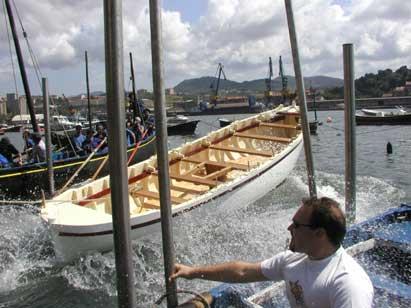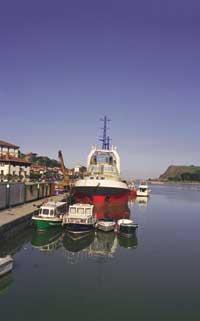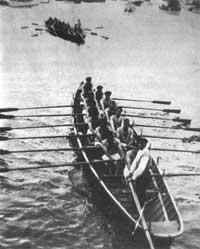Albaola looking at traditional packaging
2004/07/01 Roa Zubia, Guillermo - Elhuyar Zientzia Iturria: Elhuyar aldizkaria
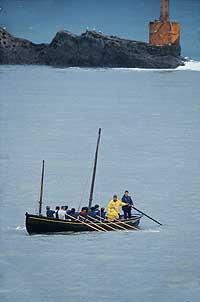
The Albaola shipyard is accessed by a slot between two houses. There, next to the entrance of the shipyard, is a very funny boat; the XIX. The same as that used in the nineteenth century for catching salmon on the Aturri River. The bow and the chopa of the boat go up, since the banks of the rivers are steep and mud, and this form favors the entry and exit of the boat.
Many do it as a gondola, perhaps the oldest ship in the Egyptians. But it is from here; it is the traditional Basque packaging. "Whoever surprises should not be surprised," explains Xabier Agote, founder of Albaola. "We should know the boats here."
The ships here do. But why the ships here? Are not all boats the same? Large traditional containers in general yes. After all, the frigates and boats of this type moved from one village to another, made long commercial trips. Through them there was a great relationship between the peoples, which made the design of the great ships easily copied from one place to another. Consequently, in all places they were similar.
On the contrary, the design of small boats varies radically from country to country, especially on the boats used by fishermen. Those here were created for use here, in a very small area, and prepared to navigate in the conditions here. In Euskal Herria the wind is not very stable, sometimes no wind flows, especially in summer. Therefore, the movement of the boat could not be based on the wind, and the oars acquired as much importance as the sail.
In Galicia and Brittany, for example, traditional boats hardly have rowing; in general, they were only used for port maneuvers, because of the wind they had. Not here. However, by the time the wind was, the candles were ready and they knew how to use them.
Basque design
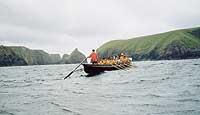
But the only difference was not that of rowing, but also changes the design of the container. It is logical, to paddle it is convenient that the boats are light. Therefore, the submerged part of the container had to have a very reduced surface, so that the water resistance was the minimum possible, just the opposite of the design of the sailboats. The trainera, for example, lacks keel and is an essential element in the sailboat.
The function of the container also influences the design. In fishing, for example, depending on the type of fish different types of boats are used. What has been used in Euskal Herria to hunt anchovy and in Galicia to hunt octopus are very different. And even if they are from the same place, depending on the type of fishing, the container to be used also varies. In fact, catching sardines and catching tuna are very different activities.
This has left a huge mark on maritime heritage. "In the boats here, and especially in the small ones, there is a huge wealth," says Agote. "Just as land architecture has left a mark on our character, the navy has also left it. But wood does not last as long as stone, and a boat is lost in fifty or sixty years."
However, although the ships rot, it would be necessary to know and recover that "maritime architecture". With this idea was born the association Albaola. The boats have been built for the first time since they disappeared from everyday life.
Back home
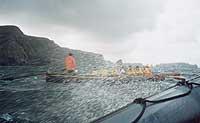
At a naval school in the state of Maine, in the United States, Xabier Agote was given the opportunity to build a Basque trainera. Agote obtained, researched and completed the plans of the trainera, material he used to manufacture his first traditional boat.
He needed money to do so, but he had a very good idea: He asked Basque groups from all over the Americas to make a trainera there and give money to all those living in the old Basque Country. Each Basque centre collaborated in the project as far as possible, but they all participated in it.
With his traineras, Agote returned to the Basque Country and organized a very special regatta to publicize the boat, with a trainera that rowed the entire Basque coast: twenty-nine stops for twenty-nine days. In addition, they were local crewmen who rode on this boat; for example, those of Orio took the boat to San Sebastián, the next day, the Donostiarras to Pasaia, etc. A total of 350 people participated.
In addition to a beautiful event, Agote managed to spread the idea through the press. This is how the Oarsoaldea Development Agency met. In this agency they were clear that Pasaia was a rather degraded environment and that it had to be promoted. They were looking for new projects.
Xabier Agote gave them the idea of converting a local of Pasai Donibane into a shipyard and not only in a shipyard, but in a center of research and construction of traditional boats. "They found it very appropriate and they helped me with enthusiasm. It's very rewarding."
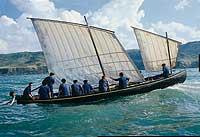
The association has been working in this shipyard for four years and is gradually forming a working group. As new employees learn the trade, boat construction continues. Seven packages have already been made. The work of the Albaola is based on the good doing of things, devoting the necessary time to the realization of each piece, ensuring the quality of the container, although it takes a lot of time.
They know how they should do things. Among other things, they can see his work, they have opened the shipyard for anyone who wants to visit. Therefore, they have installed a small museum in the back room of the shipyard.
People interested in participating in this project have room in Albaola. The name is due to a piece that the Basque boats had next to them, which joins all sides of the boat. Albaola also wants to unite people.
Agote has stressed, however, that they are not a sports or leisure club. On the other hand, despite the requests of many people, they do not accept orders. In fact, if he did, he would be obliged to work with external personnel. However, their intention is to properly train their work team. Well thought out, philosophy is suitable for a work of these characteristics, but it is not often found in these environments.
Port of Pasaia
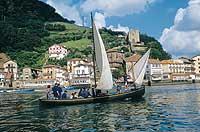
Pasaia has had great importance in marine history, as it has been the largest port of Euskal Herria, the Cantabrian and much of France. The reason is the shape of the coast, the bay is fjord-shaped, so the boats never had trouble docking. However, in other ports, the depth did not allow ships to enter low tide. Pasaia Bay offers total protection to the vessel. The next major port was La Rochelle. Although the mouth of Bordeaux is closer, the mouth of the rivers has a big problem: they have large currents.
Passages has therefore been a port of great importance, whose builders enjoyed great prestige. The residence of the Real Cofradía Guipuzcoana in Caracas is no accident. In addition, most of the men of Pasaia worked in that company, at sea, and the women remained in the same port. That's why Pasaia's famous drummers were women.
Benefits of having belly
Tricks have long been invented to avoid paying taxes. It is difficult to imagine what the modest citizens invented to sustain the little money they had or, in some cases, to turn that money into a great good. The builders' guild was no exception. Among other things, they made precious inventions to hide the cargo that ships carry.

Sometimes the story is very striking. For example, one of those tricks invented in the Middle Ages lasted years, but over time lost its link to taxes. The trick is the shape of the container.
The load, and therefore the amount of the tax, was determined by measuring the loin of the vessel; the length and the broom, that is, the width. Measurements were suitable for U-shaped helmets. On many ships, however, a kind of belly was made to the hull to shape a U deployed below and be able to carry a greater load than the limiters and taxpayers calculated.
What was originally a trap gave very good results at sea. In addition to stability, the fisher was kept by the fisher when he was collecting the net. And, therefore, this design has lasted on small boats.
Sailing for centuries
Now a boat has been thrown, that is, the XIX. In the twentieth century a boat was used to capture the sea bream and hake. But they already have another idea to keep working. XVI. They want to build a galleon of the twentieth century and for this they have sought the right place.
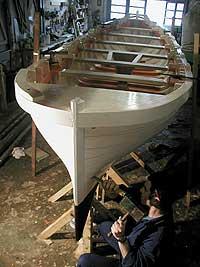
In the shipyard of Pasai Donibane you can build boats up to nine meters in length and the galleon will have 23 meters. The Provincial Council of Gipuzkoa will cede an old shipyard in Pasai San Pedro to make the galleon.
XVI. In the nineteenth century, the galleons were used to go fishing whales; they went to Newfoundland, where the whale was hunted and the oil extracted from the animals was brought in barrels to the Basque Country. However, these were not large ships, similar in size to the current one.
Two centuries later, the ships were conditioned for war; they had to introduce cannons, weapons, many soldiers and water, food, etc. necessary to supply all this. Therefore, the galleons became great ships. In the 20th century. This change not only affected the naval sector but also the forestry sector.
The builders of Albaola want to make the galleon of San Juan. This highly studied boat is an important boat, chosen by UNESCO as a logo of underwater heritage. It is not little!

Gai honi buruzko eduki gehiago
Elhuyarrek garatutako teknologia



